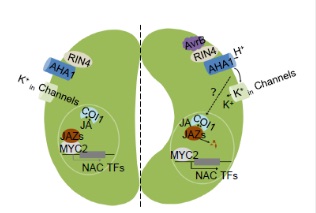Plant Cell:中科院遗传所周俭民研究组发表植物先天免疫研究进展
病原细菌在侵染植物时需要分泌一系列效应蛋白到宿主细胞内,通过作用于特定靶点,改变植物的生理活动,以利于细菌的入侵或定殖。研究效应蛋白的作用机理不仅使得我们认识病原细菌如何完成致病这一复杂生物学过程,还能帮助我们认识植物生物学本身的内在机制。
中国科学院遗传与发育生物学研究所周俭民研究组的研究发现,丁香假单胞菌效应蛋白AvrB通过与RIN4相互作用,正调控H+-ATPase AHA1的活性,从而导致气孔张开,以利于细菌的入侵。意想不到的是,AHA1 对气孔保卫细胞运动的调控并非仅仅通过改变离子通道就可实现,而是通过产生一未知信号,促进茉莉素受体COI1与转录抑制子JAZ的相互作用并增强茉莉素信号通路来实现的。
该研究结果于2015年7月21日发表在Plant Cell上(2015 Jul 21;doi/10.1105/tpc.15.00466)。周俭民研究组的助理研究员周朝阳为第一作者,中国科学院遗传与发育生物学研究所的李传友研究员和中国农业大学的郭岩研究员也参与了该项工作。该项研究得到了中国科学院先导研究计划、科技部973项目以及国家自然科学基金的资助。

AvrB促进气孔打开的模型
原文链接:
An Arabidopsis Plasma membrane Proton ATPase Modulates JA Signaling and Is Exploited by thePseudomonas syringae Effector Protein AvrB for Stomatal Invasion
原文摘要:
Stomata are natural openings through which many pathogenic bacteria enter plants. Successful bacterial pathogens have evolved various virulence factors to promote stomatal opening. Here, we show that the Pseudomonas syringae type III effector protein AvrB induces stomatal opening and enhances bacterial virulence in a manner dependent on RPM1-INTERACTING4 (RIN4), which promotes stomatal opening by positively regulating the Arabidopsis plasma membrane H+-ATPase (AHA1), which is presumed to directly regulate guard cell turgor pressure. In support of a role of AHA1 in AvrB-induced stomatal opening, AvrB enhances ATPase activity in plants. Unexpectedly, AHA1 promotes the interaction between the jasmonate (JA) receptor CORONATINE INSENSITIVE1 (COI1) and JASMONATE ZIM-DOMAIN (JAZ) proteins and enhances JA signaling. JA signaling is required for optimum stomatal infection in AHA1-active plants. Similarly, AvrB also induces the COI1-JAZ9 interaction and the degradation of multiple JAZ proteins. AvrB-induced stomatal opening and virulence require the canonical JA signaling pathway, which involves the COI1 and NAC transcription factors. The findings thus point to a previously unknown pathway exploited by P. syringae that acts upstream of COI1 to regulate JA signaling and stomatal opening.
doi:10.1105/tpc.15.00466
作者:周俭民

